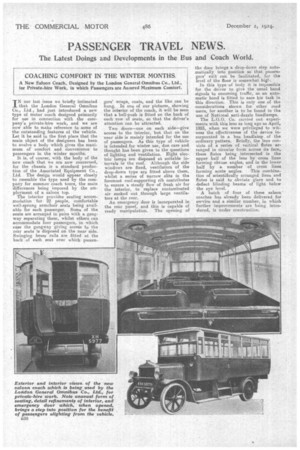PASSENGER TRAVEL NEWS.
Page 22

If you've noticed an error in this article please click here to report it so we can fix it.
The Latest Doings and Developments in the Bus and Coach World.
COACHING COMFORT IN THE WINTER MONTHS.
A New Saloon Coach, Designed by the London General Omnibus Co., Ltd., for Private-hire Work, in which Passengers are Assured Maximum Comfort.
TN our last issue we briefly intimated
that the London General Omnibus Co., Ltd, had just introduced a new type of motor coach designed primarily for use in connection with the company's private-hire work, and we are now able to make reference to some of the outstanding features of the vehicle. Let it be said in the first place that the main object of the designers has been to evolve a body which gives the maximum of comfort and Convenience to passengers in the winter months.
It is, of course, with the body of the new coach that we are now concerned, for the chassis is a standard. production of the Associated Equipment Co., Ltd. The design would appear closely to resemble the type used by the company for summer coach tours, the main differences being imposed by the employment of a saloon top.
The interior provides seating accommodation for 22 people, comfortable well-sprung armchair seats being available for each passenger. Some of the seats are arranged in pairs with a gangway separating them, whilst others can accommodate four passengers, in which case the gangway giving access to the rear seats is disposed on the near side. Swinging brass rails are fitted at the back of each seat over which passen gers' wraps, coats, and the like can be hung. In one of our pictures, showing the interior of the coach, it will be seen that a bell-push is fitted on the back of each row of seats, so that the driver's attention can be attracted.
Two doors—one on each side--give access to the interior, but that on the near side is mainly intended for the use of passengers. As this type of vehicle is intended for winter use, due care and thought has been given to the questions of lighting and ventilation. Eight electric lamps are disposed at suitable intervals in the roof. Although the side windows are fixed, ventilators of the drop-down type are fitted above them, whilst a series of narrow slits in the foremost roof-supporting rib contributes to ensure a steady flow of fresh air for the interior, to replace contaminated air sucked out through large ventilators at the rear.
An emergency door is incorporated in the rear panel, and this is capable of ready manipulation. The opening of
the door brings a drop-down step automatically into position so that passengers' exit can be facilitated, for the level of the floor is somewhat higl..
In this type of body it is impossible for the driver to give the usual hand signals to oncoming traffic, so an automatic hand is fitted to ease his task in this direction. This is only one of the considerations shown for other road users, for another is to be found in the use of National anti-dazzle headlamps.
The L.G.O. Co. carried out experiments with this lens as long ago as April, 1923, when we were privileged to wit nese the effectiveness of the device incorporated in a bus headlamp of the ordinary pattern. Briefly, the lens consists of a series of vertical flutes arranged in circular form across its face, these flutes being intersected in the upper half of the lens by cross lines forming obtuse angles, and in the lower half by a number of cross lines
forming acute angles. This combination of scientifically arranged lines and flutes is said to obviate glare and to deflect blinding beams of light below the eye level.
A batch of four of these saloon ' coaches has already been delivered for service and a similar number, in which further improvements are being intro-duoed, is under construction.
































